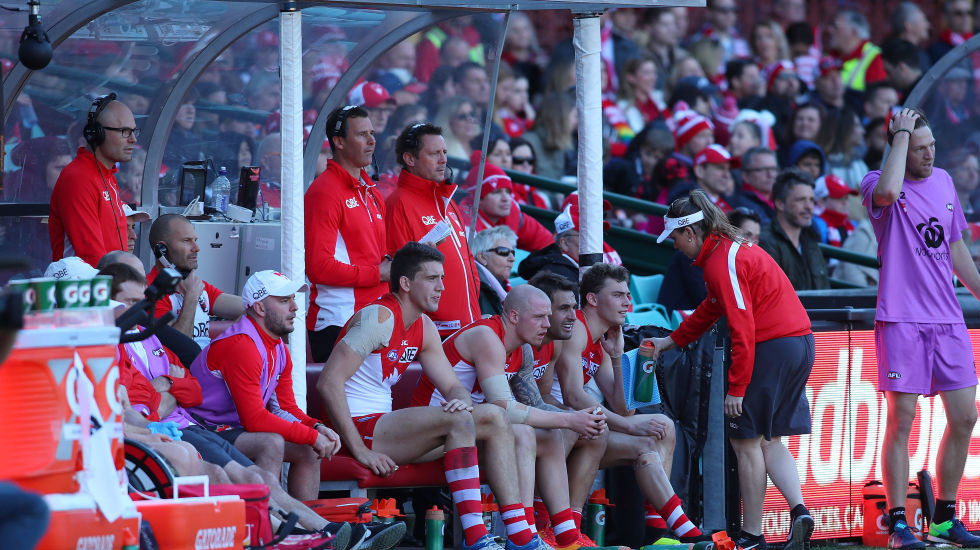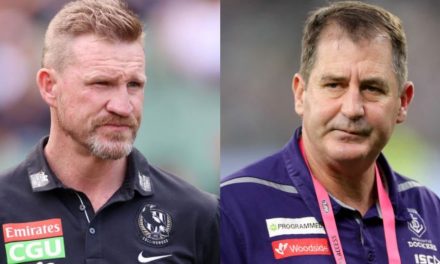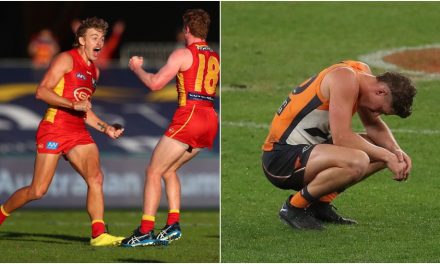Benched? Sydney’s finals spot is in jeopardy and the perennial September player’s fortunes could hang on a Round 22 clash with GWS. Photo: AFL MEDIA
Fighting through finals field will be a tougher task in 2018
AFL football over the years has had a fortunate habit of providing swings and roundabouts, for players, clubs, sometimes even for the game as a whole.
A player who fluffs his lines at a critical moment might just as quickly have the opportunity to win the game and nail it. A team might have a bad run with umpiring for a week or two then end up on the receiving end of some good fortune via the whistle blowers.
We’re seeing a broader version right now, too, in the state of the game debate. Just when the prospect of dramatic rule changes to open up congested and drab football seemed a fait accompli, the past few weeks have served up some tremendously entertaining contests, higher scores, and last Saturday at Geelong, one of the best games of the past few years.
And perhaps in 2018 we might get lucky with another example, via the most competitive final eight an AFL season has seen for some time.
With five rounds to play, it’s already apparent that some very capable teams are going to miss out on September action.
Just two wins separate nine teams occupying positions between fourth and 12th on the ladder. Only one of them will end up with the coveted double chance. Another four will at least get a tilt at a flag. But four will miss the boat altogether. And as many as three of them with win-loss records which in most years would have guaranteed them a finals spot.
You can argue strongly that the best teams (and premiers) of the past few seasons haven’t been quite as strong as their predecessors.
It’s a premise with which I largely agree. Were Richmond and the Western Bulldogs of the last two seasons to take on, say, Geelong (2007-11) or Brisbane (2001-03) in a hypothetical grand final, I’d definitely have my money on the latter pair.
But while there’s a variety of explanations for the cream at the top not being quite as thick these days, the expansion of the competition the most obvious, one positive trade-off is an evening out of the eight teams which end up contesting the pointy end of the season.
If you need statistical evidence, consider this. It’s almost certain at least one team, potentially two, will end up missing out on finals despite having recorded 13 wins. And that will be creating a slice of unwanted history.
For no team has missed out on September with that many victories over the course of a season since the introduction of the final eight in 1994, some 25 seasons ago.
It’s a continuation of an evolving trend which has already and will continue to serve up unpredictable finals series.
While the Bulldogs in 2016 became the first side to win a premiership from seventh spot on the ladder, it’s often overlooked that they managed to win 15 games along the way, easily the most a side finishing that low has won.
And in the two years preceding that, North Melbourne went from the bottom half of the eight to successive preliminary final appearances.
In the first 14 seasons of the current final eight system between 2000-13, only twice did the top four on the ladder after the home and away season not end up playing off in the preliminary finals.
Port Adelaide in 2001 and West Coast in 2007 both went out in straight sets, but they were just two of 28 qualifying final losers who weren’t able to shrug off lower-qualified opponents the following week.
But over the last four seasons, it’s been four out of eight teams which have lost qualifying finals then been upset and tipped out of September the following week by lower-ranked sides, both Geelong and Fremantle in 2014, Sydney in 2015 and Hawthorn two years ago.
Teams filling the lower half of the eight are no longer finals cannon fodder, and this season that’s certainly going to be the case.
Currently, it’s a group including a preliminary finalist of the past two seasons in the Giants and another side in Hawthorn still containing the nucleus of a line-up which managed to win three flags in a row not all that long ago.
Outside the eight is Geelong, good enough to have win six out of its 10 games to date against the current top eight, a grand finalist of last year in Adelaide, one of only four teams to knock over Richmond this season, and North Melbourne and Essendon, both of whom have won around half their games against the top eight.
Should any of them clamber into the finals, they’ll have enough runs on the board to have their prospective opponents a little anxious at least.
So tight is the squeeze between fourth and 12th right now that Sydney could potentially finish sixth or 10th dependent upon the result of just one game, the Swans’ local derby against Greater Western Sydney in round 22. That is a final three weeks before we’ve even started the real thing.
While Richmond might be undisputed top dog for now, if the Tigers do end up going back-to-back it will be a premiership with no “gimmes” along the way.
The top teams of today might not be quite as good as they used to be. But in the AFL’s on-going game of swings and roundabouts, there’s plenty of evidence that they’re having to fight even harder than their predecessors to take out the same prize.
*This article first appeared at SPORTING NEWS.












Hopefully that earlier comment over your grammatical error Rohan, was a private joke from a friend. If not, get a life Greg!
Normally the narrative we hear from the footy pundits regarding the top 8 is….. whomever has made the top 8 by the byes usually plays finals with scant regard given to the rest of the field. Some times this scenario eventuates, other times it doesn’t. Fortunately this year we haven’t had to hear that narrative. (Instead we get the ” its Richmond’s to lose” ) Its very refreshing to have the fight for a finals berth still so wide open among so many teams. Having another see sawing final round a la Adelaide v West Coast 2017, with Melbourne’s fate in their hands, was quite amazing. Hopefully this year we get to see the same final round dramas, the only difference being more teams are still alive.
Just hoping the Swans finish 7th or 8th so we don’t get any home finals!!! 😀
Altho.. Swans form after a bye is not good… and the Cats’ is abysmal… so week 1 will be a mighty challenge for both. (Cats only win after any bye, i believe, was the 2015 qualifying final when Isaac Smith missed a goal after the siren)
Hi Rohan,
Normally I quite enjoy your writing. Today however I was disappointed with what I saw as lax grammatical construction in paragraph 9 of the article, where you state “one positive trade-off is an evening out of the eight teams…”, which suggests the frankly quite silly idea that the eight teams are going out for the evening (to the movies or something). This doesn’t make sense. And of course to give you credit where it’s due that may not have been what you meant at all.
kind regards,
Greg De Vere